RENAISSANCE AND THE VIRTUAL: THE BACK PARTS OF SATAN
RENAISSANCE AND THE VIRTUAL: THE BACK PARTS OF SATAN
Author(s): Boris BerićSubject(s): Comparative Study of Literature, Theory of Literature, British Literature
Published by: Filološki fakultet, Nikšić
Keywords: Renaissance; virtual environments; printing press; Milton; Paradise Lost;
Summary/Abstract: The virtual has remained ―invisible‖ in Renaissance studies in spite, and probably because, of the developing virtual reality technologies and their most expedient potential in military training, games, and teledildonics. When it does attract scholarly attention, it is still in conjunction with negative connotations it has received in contemporary philosophy and culture, linking it to the unreal, simulacra, visual fake, copy or ―false approximation‖. It is not surprising then that both in contemporary and Renaissance studies Satan appears to be the creator of the virtual. However, the virtual must not be confused with the visual or actualized forms that it effects. It is a powerful impulse that becomes perceptible in transductions of sensible things from one medium into another, like sound into architectural structures or visible forms. The Renaissance culture teems with such transduction. A very significant one occurs in the area of linguistics as language – already transduced from sound into writing – becomes virtualized for the second time by the printing press. What Bill Gates and others have done to virtualize the individual and community in our time, another Bill, William Caxton, did for England at the end of the fifteenth century. Mass production of books led to transductional activities of translation, reading, and interpretation, creating new virtual spaces and communities outside of the existing monopolies of knowledge.
Journal: Folia Linguistica et Litteraria
- Issue Year: 2017
- Issue No: 19
- Page Range: 9-20
- Page Count: 12
- Language: English

